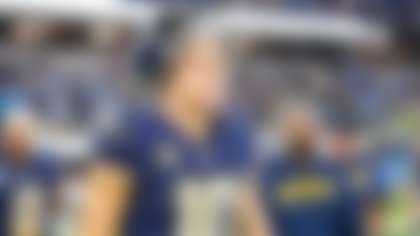In baseball, even the ace of the staff has off days. And there are times when the manager will take the long walk to the mound in the early innings, snag the ball from his stud pitcher and tell him, "Let's get 'em next time." In hockey, if the defense breaks down and the rout is on, a coach sometimes will lift even a great goaltender in the middle of a game -- the thought being that neither the keeper nor the team is well-served in watching the last line of defense yield goals in bunches.
In football -- especially in the 21st-century, media-saturated world of modern America -- lifting the quarterback is a bit different. It resonates in different ways. And in the NFL, the act itself is now tantamount to starting a quarterback controversy.
It's tough to have to replace a starting quarterback due to injury -- and the Cowboys, Steelers, Colts and Saints already have been forced to do that. But in these cases, the coach and the overall organization are somewhat innocent bystanders reacting to the shock of losing their biggest asset. When a team makes the change to a new quarterback during the course of the week, it is often an organizational decision, made with deliberate thought and discussion between the head coach, offensive coordinator, quarterbacks coach, general manager and probably even the owner. Again, we already see multiple examples of this playing out in the 2015 season -- teams assessing immediate needs (playing the quarterback "who gives us the best chance to win") vs. developmental needs (playing a youngster who could be the future of the franchise). That's the case in Cleveland and Houston.
However, when you pull a quarterback during the course of a game, this is usually not a decision that was even discussed during the week. And when the head coach makes that decision, it often comes as a surprise to everyone, from the owner all the way down to the P.A. announcer.
When Detroit Lions head coach Jim Caldwell pulled Matthew Stafford in the midst of a 42-17 blowout loss to the Arizona Cardinals on Sunday, it was a classic case of an organization in distress that might have -- unintentionally -- exacerbated that sense of crisis.
Was it a defensible move, in theory?
Perhaps.
Let's begin with the fact that Arizona is a pretty good defense. In its four games leading up to Sunday's contest against the Lions, the Arizona defense had racked up seven interceptions and seven sacks against the Saints, Bears, 49ers and Rams. And in Detroit, the unit certainly made its mark with six takeaways (including four picks) and a sack. How much of this falls on Stafford's poor play? Well, the starting QB actually led the Lions on a seven-play, 77-yard touchdown drive in the first quarter, giving Detroit a 7-0 lead. So it wasn't all bad. Unfortunately, that was the end of the positive vibes for Detroit.
When Caldwell pulled the plug on No. 9, Stafford had three picks (two of which led to Arizona TDs) and the Lions trailed 35-7 halfway through the third quarter. Stafford's passer rating (33.2) and yards per attempt (5.9) were far below acceptable -- though it must be stated that Detroit's shaky offensive line certainly didn't help the signal caller. Regardless, the game appeared to be pretty much over. (The fans booing the home team in Ford Field certainly felt that was the case.)
Trying to decipher Caldwell's mindset at that point, yes, it's easy to imagine him thinking, "We just need to make a change." Or I can see him deducing the unspoken truth, given the ferocity of Arizona's defense: "I can't leave my quarterback in there or he might get killed."
It pretty much had to be one of those two sentiments, though, because no one with the Lions is going to stand up in front of the media and say, with a straight face: "Dan Orlovsky gives us the best chance to win." (That's not a knock on Orlovsky -- it's a compliment to Stafford, who has elite tools and has shown real grit in his years with Detroit. Still just 27, he's a talented -- and a potentially special -- player.) Sometimes, the decision is an emotional one, and I think that was the case in this instance, even though Caldwell does not appear to be a man who is often swayed by emotion.
Immediately after the game, Caldwell invoked the aforementioned baseball analogy: "It's like a pitcher not having a very good day." But here's the problem: The metaphor doesn't really hold up to scrutiny. Most starting pitchers don't finish their games. Almost all starting quarterbacks do. When pitchers are pulled from a single bad outing, everyone knows the guy's spot in the rotation generally is secure. When a starting quarterback is pulled, we're often just hours away from the "Who should start at quarterback?" online poll and open lines on talk radio.
Caldwell, to his credit, stressed in the postgame press conference that Stafford remains the top dog: "He's still our starter, so there will be no issues there. There is no quarterback controversy or anything of that nature."
But what happens the next time Stafford gets pick-happy? Does he start looking over his shoulder? Do a couple of linemen start wondering if their leader will get lifted again? Even if it's unintentional, the coach has now planted a seed of uncertainty around the franchise signal caller. And that's just another concern for a club that has been one of the NFL's most disappointing in 2015.
Yes, Detroit is a bad football team right now, and it's certainly not all on Stafford. The Lions continue to lack any semblance of a running game, ranking dead last in that area by a comfortable margin. Meanwhile, the defense, which ranked second in total D and third in scoring D last season, currently ranks 22nd and 26th in those marks in 2015. The Lions already have matched their regular-season loss total from last year's 11-5 playoff campaign, and it goes far beyond the play of the quarterback. Still, Caldwell was brought to Detroit with Stafford in mind.
When Caldwell was hired, it was believed that he could optimize Stafford's strengths without wearing him out. From 2011 to '13 -- the pre-Caldwell era -- nobody threw more passes than Stafford, who averaged 675 attempts per year (with an astonishing 727 in 2012). Caldwell reduced that number to 602 last season, but through the first four weeks of the season (before Sunday's benching), Stafford was on pace for 652 attempts this year. That is all well and good when you are throwing for more than 4,000 yards -- and particularly, when you have a bunch more TDs than INTs. Stafford did just that in 2011, posting a 41-to-16 TD-to-INT ratio. But in the three-plus years since then, the ratio is 77-to-56. Certainly not ideal.
Caldwell knows his tenure in Detroit is directly tied to Stafford. At 0-5, with an organization that knows what it is like to be 0-16, it is unlikely Caldwell would be given the time to move past the Stafford era to find a new franchise quarterback for the Lions.
Thus, while Sunday's move was defensible in theory, it feels different in practice.
In the midst of a difficult season, Caldwell might have opened a rift with his most important player, created some doubt around the QB in the mind of his teammates, and left himself open to a hundred vexatious questions from reporters with the word "controversy" in them.
The Lions have a chance to log their first win of the season on Sunday, hosting the gritty-but-ailing Chicago Bears. But if you're Jim Caldwell, you go into that game knowing that if Stafford starts slowly, this is going to be in the back of everyone's head -- players, fans and media alike.
Follow Brian Billick on Twitter @coachbillick.




